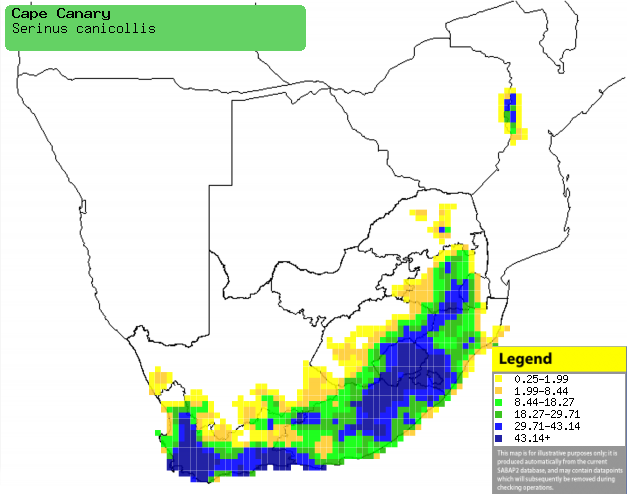|
Serinus canicollis (Cape
canary)
Kaapse kanarie [Afrikaans]; Umlonji [Xhosa]; umZwilili
[Zulu]; Toere (generic term for canaries and siskins) [South Sotho]; Twere
[North Sotho]; Risunyani, Vusunyani, Ritswiri [Tsonga]; Geelkruinkanarie
[Dutch]; Serin du Cap [French]; Gelbscheitelgirlitz [German]; Canįrio-de-nuca-cinzenta
[Portuguese]
Life
> Eukaryotes >
Opisthokonta
> Metazoa (animals) >
Bilateria >
Deuterostomia > Chordata >
Craniata > Vertebrata (vertebrates) > Gnathostomata (jawed
vertebrates) > Teleostomi (teleost fish) > Osteichthyes (bony fish) > Class:
Sarcopterygii (lobe-finned
fish) > Stegocephalia (terrestrial
vertebrates) > Tetrapoda
(four-legged vertebrates) > Reptiliomorpha > Amniota >
Reptilia (reptiles) >
Romeriida > Diapsida > Archosauromorpha > Archosauria >
Dinosauria
(dinosaurs) > Saurischia > Theropoda (bipedal predatory dinosaurs) >
Coelurosauria > Maniraptora > Aves
(birds) >
Order: Passeriformes > Family: Fringillidae
Distribution and habitat
Endemic to southern Africa, occurring in Zimbabwe's eastern
highlands and adjacent Mozambique as well as in Swaziland, Lesotho and South
Africa, from Limpopo Province south to KwaZulu-Natal and west through the Free
State and the Eastern Cape to the Western Cape. It generally prefers montane
grassland with scattered shrubs an patches of Ouhout (Leucosidea sericea),
open savanna, Protea woodland, borders between drainage line woodland and
Karoo shrubland, coastal dunes, edges of cultivated land and occasionally alien
thickets of Port Jackson (Acacia saligna) and Rooikrans (Acacia
cyclops).
|
 |
|
Distribution of Cape canary in southern Africa,
based on statistical smoothing of the records from first SA Bird Atlas
Project (©
Animal Demography unit, University of
Cape Town; smoothing by Birgit Erni and Francesca Little). Colours range
from dark blue (most common) through to yellow (least common).
See here for the latest distribution
from the SABAP2. |
Predators and parasites
It (at different stages of development) has been recorded
as prey of the following animals:
- Adults
- Felis catus (Domestic cat)
- Chicks
Additionally nestlings may be parasited and killed by the
blood-sucking fly Passeromyia heterochaeta.
Movements and migrations
Resident and mainly sedentary, although it may
make nomadic movements especially towards the outskirts of its
distribution.
Food
It almost exclusively eats seeds, either taken directly
from plants or plucked from bare patches of the ground. The following food items have been recorded
in its diet:
- Plants
- Seeds
- Alyssum
- Amaranthus (pigweeds)
- Arctotheca (botterbloms)
- Athanasia (geelblombossies)
- Boerhavia (kleefbossies)
- Casuarina (beefwoods)
- Chenopodium (fat hens)
- Echium (bloudisseldorings)
- Dicerothamnus rhinocerotis (Renosterbos)
- ericas (Ericaceae)
- Eriocephalus (Karoo rosemaries)
- Gnidia (aandbossies)
- Inula (khakiweeds)
- Lepidium (birdseeds)
- Metalasia muricata (Blombossies)
- Olea (wild olives)
- Osteospermum (bitous)
- Oxalis (suurings)
- Poa (meadow grasses)
- Senecio (groundsels)
- Silene (wild tobaccos)
- Sonchus (milk thistles)
- Stellaria (chickweeds)
- Stoebe
- Ursinia
- Venidium (Namaqua marigolds)
- flowers
- flower buds of Buddleia (sagewood)
- fruit
- Insects
Breeding
- Monogamous and usually a solitary nester, although it sometimes forms
loose colonies with up to 12 nests in a few adjacent trees.
- The nest is built almost entirely by the female in roughly 2-3 weeks,
consisting of a thick-walled cup of tendrils, especially from everlastings (Helichrysum),
also with lichens, leaf petioles, mosses, rootlets, small twigs, pine
needles and sometimes pieces of rags, string, wool and cotton. The interior
is lined with the hairy and downy pappuses of seeds, fluffy Karoo rosemary (Eriocephalus)
seeds, other plant down, hair, feathers and wool. The rim of the structure
is always made of rootlets, and is used by the chicks to deposit faeces (a
unique behaviour of canaries). It is typically placed in a vertical fork or
a horizontal branch of a bush or tree, which in the Western Cape is more
frequently an introduced species rather than an indigenous one.
- Egg-laying season is from about August-February, peaking from
October-December.
- It lays 1-5 eggs, which are incubated solely by the female for about
12-16 days, while the male regularly feeds her at the nest.
- The chicks are brooded by their for the first two days of their lives
while the male feeds all of them, after which the female remains on the nest
to protect the nestlings from rain or sun by standing with wings
outstretched. They eventually leave the nest after about 15-19 days and
after two days or so are able to fly, after which they still remain
dependent on their parents for some time.
Threats
Not threatened.
References
-
Hockey PAR, Dean WRJ and Ryan PG 2005. Roberts
- Birds of southern Africa, VIIth ed. The Trustees of the John Voelcker
Bird Book Fund, Cape Town.
|
